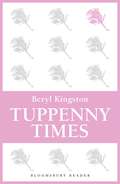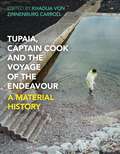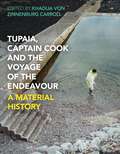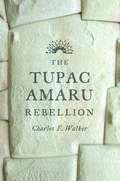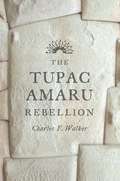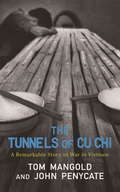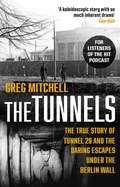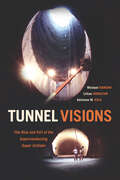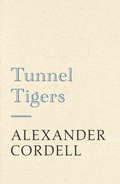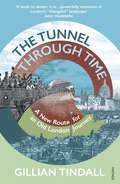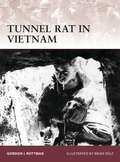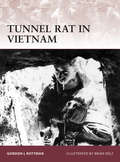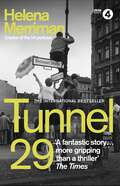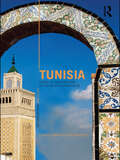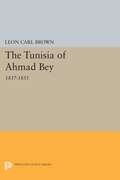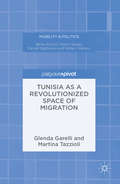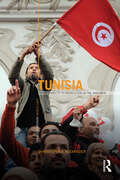- Table View
- List View
Tuppenny Times (Easter Ser. #Pt. 1)
by Beryl KingstonSpirited and independent, lady's maid Nan Smithen has ambitions far beyond her station. Marriage to a wealthy businessman enchanted by her youth brings her position, children and a comfortable union. Until her doting husband is killed on an ill-fated trip to revolutionary France.Alone with three young children, Nan faces a bleak future, for there is no money left. But the strength of will that brought her this far drives her on. A newswalk in Mayfair is her first step towards establishing a business empire that will soon stretch throughout London and beyond. Nan's fortune starts to grow.Then Calverly Leigh, a dashing – and dangerous – cavalry officer waltzes into Nan's life and she discovers there is much, much more to life than selling the Tuppenny Times.Tuppenny Times, first published in 1989, is the first book of the Easter Empire trilogy.
Tupaia, Captain Cook and the Voyage of the Endeavour: A Material History
by Khadija von Zinnenburg CarrollCentring priest and navigator Tupaia and Pacific worldviews, this richly illustrated volume weaves a new set of cultural histories in the Pacific, between local islanders and the crew of the Endeavour on James Cook's first 'voyage of discovery' (1768-1771). Contributors consider material collections brought back from the voyage, paying particular attention to Tupaia's drawings, maps, cloth and clothes, and the attending narratives that framed Britain's engagement with Pacific peoples. Bringing together indigenous and Pacific-based artists, scholars, historians, theorists and tailors, this book presents a cross-cultural conversation around the concepts of acquired and curated artefacts that traversed oceans and entwined cultures. Each chapter draws attention to a particular material, object or process to reveal fresh insights on the voyage, the societies it brought together and the histories it transformed. Authors also explore animal iconography, instruments and ethnomusicology, and performances and rituals. This work challenges colonial museum collections and celebrations of Cook's voyages, using materials old and new to make connections between past and present, whilst reinforcing Tupaia's agency as both a historical figure and a contemporary muse. Tracing overlapping folds of symbolism, this book draws together a picture of the diverse materials and people at the centre of cultural exchange.
Tupaia, Captain Cook and the Voyage of the Endeavour: A Material History
Centring priest and navigator Tupaia and Pacific worldviews, this richly illustrated volume weaves a new set of cultural histories in the Pacific, between local islanders and the crew of the Endeavour on James Cook's first 'voyage of discovery' (1768-1771). Contributors consider material collections brought back from the voyage, paying particular attention to Tupaia's drawings, maps, cloth and clothes, and the attending narratives that framed Britain's engagement with Pacific peoples. Bringing together indigenous and Pacific-based artists, scholars, historians, theorists and tailors, this book presents a cross-cultural conversation around the concepts of acquired and curated artefacts that traversed oceans and entwined cultures. Each chapter draws attention to a particular material, object or process to reveal fresh insights on the voyage, the societies it brought together and the histories it transformed. Authors also explore animal iconography, instruments and ethnomusicology, and performances and rituals. This work challenges colonial museum collections and celebrations of Cook's voyages, using materials old and new to make connections between past and present, whilst reinforcing Tupaia's agency as both a historical figure and a contemporary muse. Tracing overlapping folds of symbolism, this book draws together a picture of the diverse materials and people at the centre of cultural exchange.
The Tupac Amaru Rebellion
by Charles F. WalkerCharles Walker examines the largest rebellion in the history of Spain's American empire, led by Latin America's most iconic revolutionary, Tupac Amaru, and his wife. It began in 1780 as a multiclass alliance against European-born usurpers but degenerated into a vicious caste war, leaving a legacy that still influences South American politics today.
The Tupac Amaru Rebellion: An Anthology Of Sources (Hackett Classics)
by Charles F. WalkerCharles Walker examines the largest rebellion in the history of Spain's American empire, led by Latin America's most iconic revolutionary, Tupac Amaru, and his wife. It began in 1780 as a multiclass alliance against European-born usurpers but degenerated into a vicious caste war, leaving a legacy that still influences South American politics today.
The Tunnels of Cu Chi: A Remarkable Story of War
by Tom Mangold John PenycateThe story of an extraordinary campaign in the Vietnam War - fought in a 200-mile labyrinth of underground tunnels and chambers.The campaign in the tunnels of Cu Chi was fought with cunning and savagery between Viet Cong guerrillas and special teams of US infantrymen called 'Tunnel Rats'. The location: the 200-mile labyrinth of underground tunnels and secret chambers that the Viet Cong had dug around Saigon.The Tunnel Rats were GIs of legendary skill and courage. Armed only with knives and pistols, they fought hand-to-hand against a cruel and ingenious enemy inside the booby-trapped blackness of the tunnels. For the Viet Cong the tunnel network became their battlefield, their barracks, their arms factories and their hospitals, as the ground above was pounded to dust by American shells and bombs.
The Tunnels: The Untold Story of the Escapes Under the Berlin Wall
by Greg Mitchell'A story with so much inherent drama... a kaleidoscopic cold war story.' The GuardianIn the summer of 1962, one year after the rise of the Berlin Wall, a group of daring young West Germans risked prison, Stasi torture and even death to liberate friends, lovers, and strangers in East Berlin by digging tunnels under the Wall. Then, as the world’s press heard about the secret projects, two television networks raced to be the first to document them from the inside, funding two separate tunnels for exclusive rights to film the escapes. In response, President John F. Kennedy and his administration, wary of anything that might raise tensions and force a military confrontation with the Soviets, maneuvered to quash both documentaries. As Greg Mitchell's riveting narrative unfolds, we meet extraordinary characters: the legendary cyclist who became East Berlin’s most wanted man; the tunneller who had already served four years in the East German gulag; the Stasi informer who betrays the ‘CBS tunnel’; the young East Berliner who escapes with her baby, then marries one of the tunnellers; and an engineer who would later help build the tunnel under the English Channel.Capturing the hopes and fears of everyday Berliners, the chilling reach of the Stasi secret police, and the political tensions of the Cold War, The Tunnels is breaking history, a propulsive read whose themes still reverberate today.
Tunnel Visions: The Rise and Fall of the Superconducting Super Collider
by Michael Riordan Lillian Hoddeson Adrienne W. KolbStarting in the 1950s, US physicists dominated the search for elementary particles; aided by the association of this research with national security, they held this position for decades. In an effort to maintain their hegemony and track down the elusive Higgs boson, they convinced President Reagan and Congress to support construction of the multibillion-dollar Superconducting Super Collider project in Texas—the largest basic-science project ever attempted. But after the Cold War ended and the estimated SSC cost surpassed ten billion dollars, Congress terminated the project in October 1993. Drawing on extensive archival research, contemporaneous press accounts, and over one hundred interviews with scientists, engineers, government officials, and others involved, Tunnel Visions tells the riveting story of the aborted SSC project. The authors examine the complex, interrelated causes for its demise, including problems of large-project management, continuing cost overruns, and lack of foreign contributions. In doing so, they ask whether Big Science has become too large and expensive, including whether academic scientists and their government overseers can effectively manage such an enormous undertaking.
Tunnel Visions: The Rise and Fall of the Superconducting Super Collider
by Michael Riordan Lillian Hoddeson Adrienne W. KolbStarting in the 1950s, US physicists dominated the search for elementary particles; aided by the association of this research with national security, they held this position for decades. In an effort to maintain their hegemony and track down the elusive Higgs boson, they convinced President Reagan and Congress to support construction of the multibillion-dollar Superconducting Super Collider project in Texas—the largest basic-science project ever attempted. But after the Cold War ended and the estimated SSC cost surpassed ten billion dollars, Congress terminated the project in October 1993. Drawing on extensive archival research, contemporaneous press accounts, and over one hundred interviews with scientists, engineers, government officials, and others involved, Tunnel Visions tells the riveting story of the aborted SSC project. The authors examine the complex, interrelated causes for its demise, including problems of large-project management, continuing cost overruns, and lack of foreign contributions. In doing so, they ask whether Big Science has become too large and expensive, including whether academic scientists and their government overseers can effectively manage such an enormous undertaking.
Tunnel Visions: The Rise and Fall of the Superconducting Super Collider
by Michael Riordan Lillian Hoddeson Adrienne W. KolbStarting in the 1950s, US physicists dominated the search for elementary particles; aided by the association of this research with national security, they held this position for decades. In an effort to maintain their hegemony and track down the elusive Higgs boson, they convinced President Reagan and Congress to support construction of the multibillion-dollar Superconducting Super Collider project in Texas—the largest basic-science project ever attempted. But after the Cold War ended and the estimated SSC cost surpassed ten billion dollars, Congress terminated the project in October 1993. Drawing on extensive archival research, contemporaneous press accounts, and over one hundred interviews with scientists, engineers, government officials, and others involved, Tunnel Visions tells the riveting story of the aborted SSC project. The authors examine the complex, interrelated causes for its demise, including problems of large-project management, continuing cost overruns, and lack of foreign contributions. In doing so, they ask whether Big Science has become too large and expensive, including whether academic scientists and their government overseers can effectively manage such an enormous undertaking.
Tunnel Visions: The Rise and Fall of the Superconducting Super Collider
by Michael Riordan Lillian Hoddeson Adrienne W. KolbStarting in the 1950s, US physicists dominated the search for elementary particles; aided by the association of this research with national security, they held this position for decades. In an effort to maintain their hegemony and track down the elusive Higgs boson, they convinced President Reagan and Congress to support construction of the multibillion-dollar Superconducting Super Collider project in Texas—the largest basic-science project ever attempted. But after the Cold War ended and the estimated SSC cost surpassed ten billion dollars, Congress terminated the project in October 1993. Drawing on extensive archival research, contemporaneous press accounts, and over one hundred interviews with scientists, engineers, government officials, and others involved, Tunnel Visions tells the riveting story of the aborted SSC project. The authors examine the complex, interrelated causes for its demise, including problems of large-project management, continuing cost overruns, and lack of foreign contributions. In doing so, they ask whether Big Science has become too large and expensive, including whether academic scientists and their government overseers can effectively manage such an enormous undertaking.
Tunnel Visions: The Rise and Fall of the Superconducting Super Collider
by Michael Riordan Lillian Hoddeson Adrienne W. KolbStarting in the 1950s, US physicists dominated the search for elementary particles; aided by the association of this research with national security, they held this position for decades. In an effort to maintain their hegemony and track down the elusive Higgs boson, they convinced President Reagan and Congress to support construction of the multibillion-dollar Superconducting Super Collider project in Texas—the largest basic-science project ever attempted. But after the Cold War ended and the estimated SSC cost surpassed ten billion dollars, Congress terminated the project in October 1993. Drawing on extensive archival research, contemporaneous press accounts, and over one hundred interviews with scientists, engineers, government officials, and others involved, Tunnel Visions tells the riveting story of the aborted SSC project. The authors examine the complex, interrelated causes for its demise, including problems of large-project management, continuing cost overruns, and lack of foreign contributions. In doing so, they ask whether Big Science has become too large and expensive, including whether academic scientists and their government overseers can effectively manage such an enormous undertaking.
Tunnel Visions: The Rise and Fall of the Superconducting Super Collider
by Michael Riordan Lillian Hoddeson Adrienne W. KolbStarting in the 1950s, US physicists dominated the search for elementary particles; aided by the association of this research with national security, they held this position for decades. In an effort to maintain their hegemony and track down the elusive Higgs boson, they convinced President Reagan and Congress to support construction of the multibillion-dollar Superconducting Super Collider project in Texas—the largest basic-science project ever attempted. But after the Cold War ended and the estimated SSC cost surpassed ten billion dollars, Congress terminated the project in October 1993. Drawing on extensive archival research, contemporaneous press accounts, and over one hundred interviews with scientists, engineers, government officials, and others involved, Tunnel Visions tells the riveting story of the aborted SSC project. The authors examine the complex, interrelated causes for its demise, including problems of large-project management, continuing cost overruns, and lack of foreign contributions. In doing so, they ask whether Big Science has become too large and expensive, including whether academic scientists and their government overseers can effectively manage such an enormous undertaking.
Tunnel Tigers
by Alexander CordellBrunel, Stephenson, Locke and Vignoles - these were the magic names.And under them 10,000 laboured, blasting, shovelling and digging, changing the contours of Britain for a new age of railways. Among them is Nick Wortley, whose love for the daughter of the local mill owner is cruelly thwarted. Taking flight he is drawn by the irresistable clamour of the great Sheffield to Manchester, a railway which is preparing to drive a path of steel under thePennines. Stephenson said it was impossible; Nick and his companions will provehim wrong, but at a terrible price...
The Tunnel Through Time: A New Route for an Old London Journey
by Gillian TindallCrossrail, the ‘Elizabeth’ line, is simply the latest way of traversing a very old east–west route through what was once countryside to the city and out again. Visiting Stepney, Liverpool Street, Tottenham Court Road and Oxford Street, Gillian Tindall traces the course of many of these historical journeys across time as well as space.The Tunnel Through Time uncovers the lives of those who walked where many of our streets still run. These people spoke the names of ancient farms, manors and slums that now belong to our squares and tube stations. They endured the cycle of the seasons as we do; they ate, drank, worked and laughed in what are essentially the same spaces we occupy today. As Tindall expertly shows, destruction and renewal are a constant rhythm in London’s story.
Tunnel Rat in Vietnam (Warrior)
by Gordon L. Rottman Brian DelfIn 1965, soon after the first US combat troops had arrived in Vietnam, it was realized that in some areas the Viet Cong had developed vast tunnel complexes in which to hide from the enemy. It was long known that such complexes existed, but it was not realized just how extensive they were in some areas, how important they were to the Viet Cong, and how difficult it was to detect and neutralize them. At first infantrymen volunteered to enter the tunnels armed with only pistols and flashlights – the 'tunnel runners' were born, known to the Australians as 'tunnel ferrets'. Starting as an ad hoc force of infantrymen, combat engineers and chemical troops, it was not long before units were 'formalized' as 'tunnel exploration personnel' and 4–6-man 'tunnel exploitation and denial teams' were created. They came to be known simply as 'tunnel rats' with the unofficial motto Non Gratum Anus Rodentum – 'Not Worth a Rat's Ass'. This title will be based on the personal accounts of those who served in this unique role and will describe the specialist training and equipment, not to mention the tactics and combat experiences, of those who fought an underground war against the Viet Cong in Vietnam.
Tunnel Rat in Vietnam (Warrior #161)
by Gordon L. Rottman Brian DelfIn 1965, soon after the first US combat troops had arrived in Vietnam, it was realized that in some areas the Viet Cong had developed vast tunnel complexes in which to hide from the enemy. It was long known that such complexes existed, but it was not realized just how extensive they were in some areas, how important they were to the Viet Cong, and how difficult it was to detect and neutralize them. At first infantrymen volunteered to enter the tunnels armed with only pistols and flashlights – the 'tunnel runners' were born, known to the Australians as 'tunnel ferrets'. Starting as an ad hoc force of infantrymen, combat engineers and chemical troops, it was not long before units were 'formalized' as 'tunnel exploration personnel' and 4–6-man 'tunnel exploitation and denial teams' were created. They came to be known simply as 'tunnel rats' with the unofficial motto Non Gratum Anus Rodentum – 'Not Worth a Rat's Ass'. This title will be based on the personal accounts of those who served in this unique role and will describe the specialist training and equipment, not to mention the tactics and combat experiences, of those who fought an underground war against the Viet Cong in Vietnam.
Tunnel 29: Love, Espionage and Betrayal: the True Story of an Extraordinary Escape Beneath the Berlin Wall
by Helena Merriman'An almost unbelievable story of bravery, endeavour, and humanity... you won't be able to put it down.' Dermot O'Leary'Merriman takes us inside not only the tunnel, but also the personal lives of those who dug it. We feel we're experiencing history as it happens. It's a gripping story of bravery, determination and, ultimately, love.' Lindsey Hillsum, International Editor for Channel 4 NewsAcclaim for the TUNNEL 29 podcast:'Combining the fun of a thriller that we know will end happily with grim perspective on history and tyranny... stunning.' New Yorker'Reminiscent of a savvy Netflix block buster series.' Evening Standard'A truly exciting yarn... creates a sense for the listener of being right there in the tunnel, experiencing the dangers.' Observer-------------------------He's just escaped from one of the world's most brutal regimes.Now, he decides to tunnel back in.It's summer, 1962, and Joachim Rudolph, a student, is digging a tunnel under the Berlin Wall. Waiting on the other side in East Berlin - dozens of men, women and children; all willing to risk everything to escape.From the award-winning creator of the acclaimed BBC Radio 4 podcast, Tunnel 29 is the true story of the most remarkable escape tunnel dug under the Berlin Wall. Drawing on hundreds of hours of interviews with the survivors, and thousands of pages of Stasi documents, Helena Merriman brilliantly reveals the stranger-than-fiction story of the ingenious group of student-diggers, the glamorous red-haired messenger, the American News network which films the escape, and the Stasi spy who betrays it. For what Joachim doesn't know as he burrows closer to East Germany, is that the escape operation has been infiltrated. As the escapees prepare to crawl through the cold, wet darkness, above them, the Stasi are closing in.Tunnel 29 is about what happens when people lose their freedom - and how some will do anything to win it back.
Tunisia: Stability And Reform In The Modern Maghreb (The\contemporary Middle East Ser.)
by Christopher AlexanderThis book gives a concise yet comprehensive overview of Tunisia’s political and economic development from the mid-nineteenth century to the present. Written specifically for a non-specialist audience, the book examines the factors that make Tunisia one of the Arab world’s most stable and prosperous countries and one of its hardiest authoritarian orders. The author explores these themes in a way that sheds light on the political dynamics of the broader Arabic-speaking, Muslim world. Christopher Alexander draws on extensive primary and secondary research and on comparison with other countries in the region to provide the most up-to-date introduction to Tunisia's post-independence politics. Challenging the notion that Tunisia’s stability is rooted in a unique political culture, he argues that Tunisia’s stability reflects the pragmatic interests of a wide range of actors and the skillful maneuvering of the country’s two presidents. Concisely written chapters cover topics such as: state formation domestic politics economic development foreign relations colonialism An essential inclusion on courses on Middle Eastern politics, African politics, and political science in general, this accessible introduction to Tunisia will also be of interest to anyone wishing to learn more about this significant region.
The Tunisia of Ahmad Bey, 1837-1855
by Leon Carl BrownUnder the energetic but confused prodding of the activist ruler Ahmad Bey, Tunisia made its first effort to institute European-inspired political and military reforms. L. Carl Brown's book on the reign of Ahmad Bey is thus a case study in modernization as well as a historical survey of Tunisia in the mid-nineteenth century. Professor Brown explains the workings of the traditional political system, an elaborate blend of Hafsid and Ottoman governmental ideas and practices. He explores the ways in which the changes imposed on Tunisia by the West made this system unworkable. Turning to the modernization movement itself, the author argues that the first phase of modernization was almost exclusively in the hands of the existing political elite, whose background, education, career pattern, and self-image he examines. This elite, working within a political climate characterized by a close interweaving of domestic and diplomatic concerns, developed an operating style described as collaborationist modernization. In addition to recapturing in a narrative history the age of Ahmad Bey and the political class over which he ruled, Professor Brown fits the Tunisian story of these years into the broader historical context of change imposed by the West on the rest of the world.Originally published in 1975.The Princeton Legacy Library uses the latest print-on-demand technology to again make available previously out-of-print books from the distinguished backlist of Princeton University Press. These editions preserve the original texts of these important books while presenting them in durable paperback and hardcover editions. The goal of the Princeton Legacy Library is to vastly increase access to the rich scholarly heritage found in the thousands of books published by Princeton University Press since its founding in 1905.
Tunisia as a Revolutionized Space of Migration (Mobility & Politics)
by Glenda Garelli Martina TazzioliThis book explores the transformation of the Tunisian space of mobility after the Arab Uprisings, looking at the country’s emerging profile as a migratory “destination” and focusing on refugees from Syria, Libya, and Sub-Saharan countries; Tunisian migrants in Europe who return home; and young undocumented European migrants living in Tunis. This work engages with and contributes to the broader conversation on the migrations-crisis nexus, by retracing the geographies of mobility which are reshaping the Mediterranean region.
Tunisia as a Revolutionized Space of Migration (Mobility & Politics)
by Martina Tazzioli Glenda GarelliThis book explores the transformation of the Tunisian space of mobility after the Arab Uprisings, looking at the country’s emerging profile as a migratory “destination” and focusing on refugees from Syria, Libya, and Sub-Saharan countries; Tunisian migrants in Europe who return home; and young undocumented European migrants living in Tunis. This work engages with and contributes to the broader conversation on the migrations-crisis nexus, by retracing the geographies of mobility which are reshaping the Mediterranean region.
Tunisia: From stability to revolution in the Maghreb (The Contemporary Middle East)
by Christopher AlexanderThe first edition of Tunisia was released just nine months before the eruption of the Arab Spring. The most substantial period of political unrest felt by the Arab world in a half century originated in Tunisia, a fact that confounded expectations about Tunisian politics. This new edition builds upon the first edition’s overview of Tunisia’s political and economic development to examine how one of the region’s hardiest authoritarian orders was toppled by a loosely organised protest wave. Providing the most up-to-date introduction to Tunisia’s post-independence and post-Arab Spring politics, concisely written chapters cover topics such as: state formation domestic politics economic development foreign relations colonialism the Arab Spring; its factors and repercussions Key to this new edition is the examination of Tunisian history, politics and society alongside the subsequent upheaval following the outbreak of revolts in December 2010. It looks at how political and economic changes after 2001, including economic deterioration and rising inequality and corruption, had already begun to erode bases of Ben Ali’s government, and explores why Tunisia is the sole Arab Spring country to construct a democracy thus far, and the challenges that this new democracy still faces. An essential inclusion on courses on Middle Eastern politics, African politics, and political science in general, this accessible introduction to Tunisia will also be of interest to anyone wishing to learn more about this significant region.
Tunisia: From stability to revolution in the Maghreb (The Contemporary Middle East)
by Christopher AlexanderThe first edition of Tunisia was released just nine months before the eruption of the Arab Spring. The most substantial period of political unrest felt by the Arab world in a half century originated in Tunisia, a fact that confounded expectations about Tunisian politics. This new edition builds upon the first edition’s overview of Tunisia’s political and economic development to examine how one of the region’s hardiest authoritarian orders was toppled by a loosely organised protest wave. Providing the most up-to-date introduction to Tunisia’s post-independence and post-Arab Spring politics, concisely written chapters cover topics such as: state formation domestic politics economic development foreign relations colonialism the Arab Spring; its factors and repercussions Key to this new edition is the examination of Tunisian history, politics and society alongside the subsequent upheaval following the outbreak of revolts in December 2010. It looks at how political and economic changes after 2001, including economic deterioration and rising inequality and corruption, had already begun to erode bases of Ben Ali’s government, and explores why Tunisia is the sole Arab Spring country to construct a democracy thus far, and the challenges that this new democracy still faces. An essential inclusion on courses on Middle Eastern politics, African politics, and political science in general, this accessible introduction to Tunisia will also be of interest to anyone wishing to learn more about this significant region.
Tunisia: Stability And Reform In The Modern Maghreb (The\contemporary Middle East Ser.)
by Christopher AlexanderThis book gives a concise yet comprehensive overview of Tunisia’s political and economic development from the mid-nineteenth century to the present. Written specifically for a non-specialist audience, the book examines the factors that make Tunisia one of the Arab world’s most stable and prosperous countries and one of its hardiest authoritarian orders. The author explores these themes in a way that sheds light on the political dynamics of the broader Arabic-speaking, Muslim world. Christopher Alexander draws on extensive primary and secondary research and on comparison with other countries in the region to provide the most up-to-date introduction to Tunisia's post-independence politics. Challenging the notion that Tunisia’s stability is rooted in a unique political culture, he argues that Tunisia’s stability reflects the pragmatic interests of a wide range of actors and the skillful maneuvering of the country’s two presidents. Concisely written chapters cover topics such as: state formation domestic politics economic development foreign relations colonialism An essential inclusion on courses on Middle Eastern politics, African politics, and political science in general, this accessible introduction to Tunisia will also be of interest to anyone wishing to learn more about this significant region.
